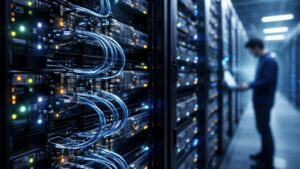Industries are gradually turning to innovative ideas to address the increasing challenges in the face of rising costs, strict regulations on the environment, and the need to reduce consumption. Digital twins are one such game-changing technology that is highly effective in industrial water management. These virtual replicas of physical systems will be explored in detail in this article. We will examine its applications, benefits, challenges, and more.
Digital Twins: Enhancing Operational Efficiency
Digital twins can show deep insights into industrial water systems. So, they enable companies to optimize their operations in real-time.
Real-Time Monitoring and Control
Digital twins give a comprehensive view of the entire water system. This can range from intake to discharge. Furthermore, it integrates data from sensors through the system. This offers the detection of anomalies almost instantly. It includes leaks or malfunctions in equipment. As a result, it leads to quick responses to issues, minimum water loss, and potential damage. Moreover, it ensures that water is meeting both production needs and regulatory standards. Additionally, the virtual replicas enable dynamic adjustments when it comes to treatment processes. This is based on the incoming water quality on production demands.
Predictive Maintenance
Digital twins analyze historical data and current conditions. This helps them predict when the equipment can fail. As a result, it enables proactive maintenance. Furthermore, this approach gives way for industries to schedule maintenance based on the actual conditions of the equipment. This is rather than fixed intervals leading to a reduction in unnecessary downtime and extending infrastructure lifespan. Moreover, predictive maintenance aids in reducing costs by addressing the potential issues before they make up a major issue in industrial water management. So, this makes it one of the best benefits of digital twins in water management.
Resource Optimization
Digital twins play a major role in optimizing resource use across the water systems in the industry. They can identify the most energy-efficient settings in operations for pumps and treatment systems. As a result, it reduces energy consumption without compromising on the water needs or quality. Moreover, the holistic view of water and energy use enables managers to make informed choices about water production and usage. Additionally, this capability aids in making a balance of resources across production lines. It leads to maximum overall efficiency.
Digital Twins: Improving Decision-Making and Planning
Digital twins are not just about improvement in day-to-day operations. They are highly effective in long-term planning and strategic decision-making in industrial water management.
Scenario Planning & Risk Assessment
Digital twins reflect the ability to simulate several “what-if” scenarios which is useful. Furthermore, industries can see how changes can affect their water systems. These changes can be new methods of production, new regulations that need to be followed, or even climate change. As a result, it allows them to see different strategies and investments virtually before committing the resources in need physically. For instance – a manufacturing unit that is considering a new water recycling system can use digital twins to simulate the integration. It can also see the impact on water quality and availability and optimize its operations. Moreover, digital twins can help industries develop a robust strategy and contingency plans.
Investment Optimization
The long-term capital planning related to industrial water management is crucial and digital twins can help in this. The simulation of different equipment and system configurations over time can help make more informed decisions as to where to allocate their resources. For instance – when seeing upgrades to wastewater treatment facilities, a digital twin can aid in prioritizing which components to replace or upgrade. This is based on condition, importance, and potential impact on the overall system. Moreover, this data-driven approach makes sure that capital investments give out the maximum possible improvements.
Regulatory Compliance & Reporting
Regulations for the environment are getting more stringent. Digital twins can be highly effective in ensuring and demonstrating compliance with it. Furthermore, these systems can monitor water quality parameters and usage patterns continuously. As a result, it provides early warning of potential non-compliance issues. Moreover, digital twins automate the majority of the data collection and reporting in need of regulatory bodies. This reduces administrative burden and improves the accuracy and timeliness of regulatory submissions. Additionally, if an environmental incident occurs, digital twins can give a comprehensive audit trail. This can help industries identify the root cause and demonstrate actions to the regulators. So, this makes it one of the most useful digital twin applications in industrial water systems.
Challenges and Future Prospects In Industrial Water Management
Digital twins show incredible potential in industrial water management. However, their implementation also brings some challenges.
Data Integration and Quality
The integration of data from multiple sources stands to be one of the major challenges in digital twins. Many industrial facilities operate on a mix of legacy systems and newer technologies. So, this makes it difficult to make a cohesive digital representation. Furthermore, data quality and consistency assurance across these disparate systems are important for the accuracy and reliability of digital twins. Advanced data integration platforms and efforts of standardization are aiding in mitigating these challenges. Moreover, ML algorithms are coming into use to clean and validate data. As a result, it ensures that digital twins are made on high-quality information.
Cybersecurity Concerns
Industrial water systems are showing immense digitalization. This makes cybersecurity concerns come to the forefront. Furthermore, digital twins with their comprehensive view of the water infrastructure can be a target for cyberattacks. Moreover, protecting the data from unauthorized access is crucial to prevent potential disruption to treatment processes. Industries are coming up with a response with an increase in investments in cybersecurity measures. This includes encrypted communications, secure access controls, and regular audits of security. Moreover, collaboration with cybersecurity experts and adherence to the best practices in data protection are also becoming standard practices in industrial water management.
Adoption and Cultural Change
The biggest challenge when it comes to digital twins is cultural rather than technological. Furthermore, several industries have established the processes and workflows for industrial water management for decades. So, making a transition to a digital approach needs not just skills but a fundamental shift in mindset. Companies are addressing this challenge with comprehensive training programs. They are also changing management initiatives and demonstrating early wins to build buy-in across the organization. Moreover, as the benefits of digital twins become more visible, resistance to adoption will fade away and lead to enthusiasm for the possibilities they can offer in revolutionizing industrial water management.
To Sum Up
Digital twins show a paradigm shift when it comes to industrial water management. They give unmatched insights, control, and predictive capabilities. So, they possess the potential to revolutionize everything from daily operations to long-term planning. Though the challenges remain, industries are quickly developing solutions to overcome these challenges. So, the impact of digital twins is set to grow majorly as it continues to evolve and mature.
If you want to know more about these types of technologies, which might shape the future direction of industrial water management, then think about attending Industrial Water & Wastewater Management Summit 2024. Taking place in Frankfurt, Germany between the 26th and 27th of September, this is a two-day summit that brings together industry players, innovators as well as experts to explore innovation for sustainability along with profitability. So hurry up and register today!




